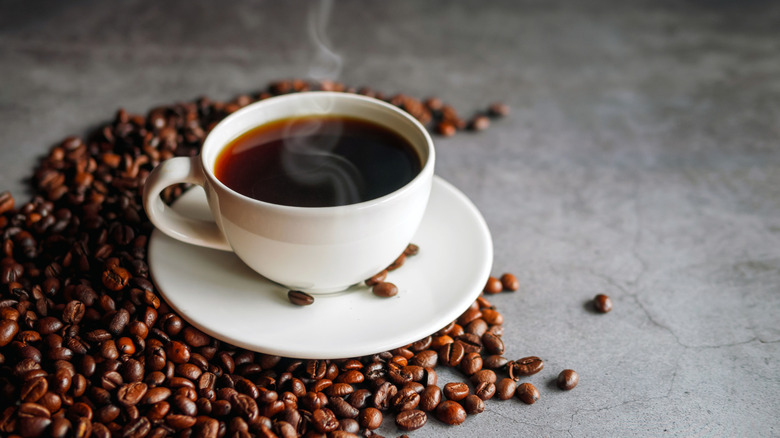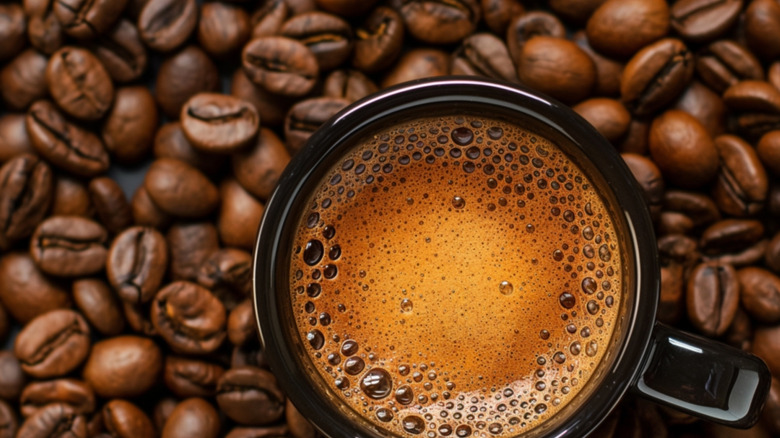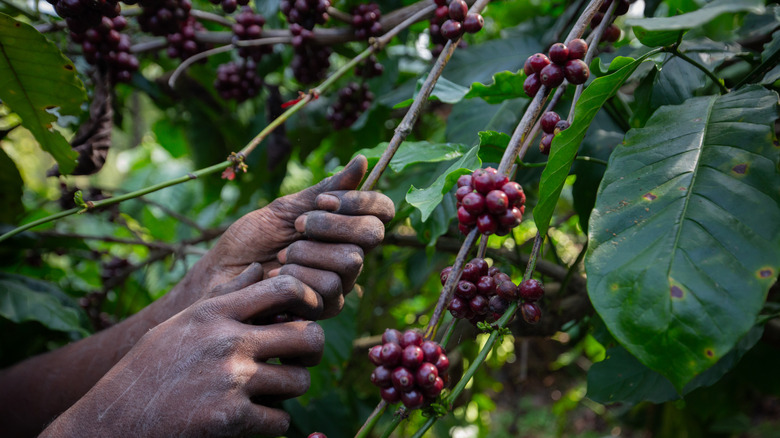Arabica Vs Canephora: The Difference Between Coffee Species
While there are many longstanding myths about coffee that should be debunked, there's more to your morning cup-a-joe than you might think. When it comes to coffee there are two primary species: arabica and canephora (commonly known for its robusta varietal). Though both of these species derive from the mother coffea plant, their differences outnumber their similarities. Growing regions, caffeine quantity, and — most importantly — taste are a few qualities that separate the two species from each other.
Before getting into the differences, let's touch on what arabica and canephora have in common. These strains of coffee from the coffea genus are all flowering plants in the shrub family with arabica and canephora being the main types farmed for commercial production. What we refer to as coffee beans aren't beans at all but the seeds within the cherry that blooms along the branches. For both species, the cherries and their seeds are often harvested by hand to best tell when each individual cherry is ripe. It's more sustainable as well, but the labor-intensive harvesting process is partially responsible for coffee's high price. Both species are native to the African continent, and Western colonization facilitated the widespread cultivation of the coffea plants throughout other countries located along or near the equator — aka the coffee belt.
Arabica is the most popular bean in the West
We may know that the key to great coffee at home is precision, but do you know how people even began consuming coffee? The popular story involves dancing goats, of all things. Supposedly, a shepherd saw goats accidentally eating the cherries of the coffea plant and subsequently dance from ingesting the caffeinated stimulant. This mythic origin for coffee consumption dates back to circa 850 B.C. in modern day Ethiopia and Yemen. Historians can't know for certain if the excited goats were ever real, but the location of the story gives us a clear idea of which type of coffea plant they would have allegedly eaten — arabica. This species thrives in the higher altitudes found in that region, near the equator.
The higher elevation lengthens the growing period, giving the coffee cherries more time to develop a richer and more complex flavor. The depth of flavor in the coffea arabica species is what makes it the prime choice for major coffee brands. Coffee corporations like Starbucks and Dunkin' source only arabica beans, and most coffee available for purchase in stores will be arabica as well. Arabica is by far the more popular in the West of the two main species, despite it having the lesser amount of caffeine by weight — all thanks to its more mellow, developed flavor.
Canephora is hardier and easier to grow
Perhaps better known throughout the coffee world by its predominant varietal, robusta, coffea canephora's uses are much less flashy than its sister species. Growing at lower elevations, the speed at which the cherry ripens does no favors in terms of taste. Many compare the smell and taste of the brew to that of burned rubber due to the high acidity and lack of developed sugars within the fruit at harvest.
In regions where it's commonly grown and used, like Indonesia and Vietnam, the bitterness and aggressive flavor are masked by adding large amounts of sugar and condensed milk — though a milk shortage led to the creation of Vietnamese egg coffee. What canephora lacks in flavor, it makes up for in caffeine content. When it comes to which has the most caffeine, arabica loses: Canephora has nearly double the caffeine than arabica, which is why instant coffee is made out of brewed robusta. It's also used in coffee extracts and energy drinks — all products where the flavor of the product is overlooked in favor of the caffeine hit.
Unlike arabica, canephora cross-fertilizes giving us many strains like conilon and recently some arabica hybrids as a way to improve the flavor quality when brewed. Within the past few years, there has been an uptick in canephora production as the canephora strains are perfected for larger Western use.



